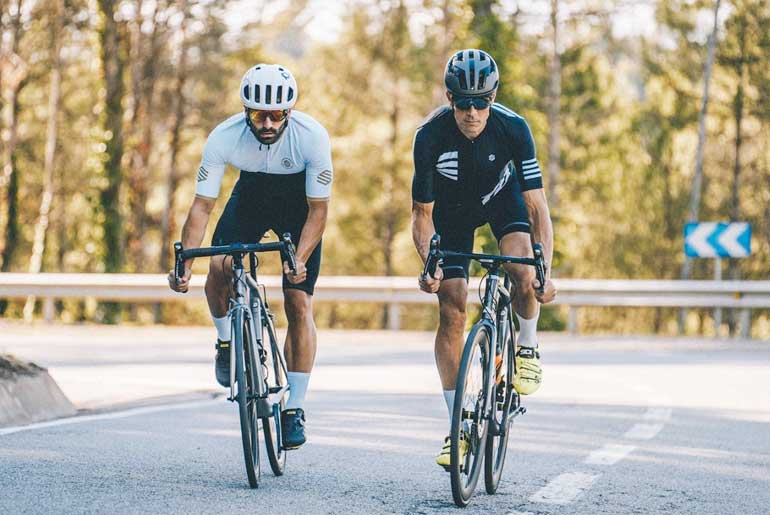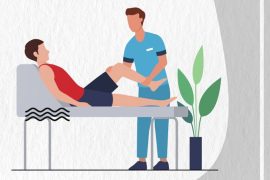Cycling is a versatile and popular physical activity that involves riding a bicycle, a two-wheeled vehicle powered by pedaling. It offers a wide range of benefits for individuals of all ages and fitness levels, making it an excellent choice for both recreational enjoyment and fitness. With various disciplines like road cycling, mountain biking, commuting, and more, cycling can be tailored to suit different preferences and goals.
One of the key advantages of cycling is its positive impact on cardiovascular health. Regular cycling improves heart health, strengthens blood vessels, and reduces the risk of heart diseases. It engages major muscle groups, including the quadriceps, hamstrings, calves, and glutes, promoting muscle strength and endurance. Unlike high-impact activities, cycling is gentle on the joints, making it suitable for people with joint issues or those recovering from injuries.
Beyond its physical benefits, cycling also contributes to mental well-being. Riding outdoors provides an opportunity to connect with nature, reduce stress, and enhance mental clarity and mood. The eco-friendly nature of cycling as a mode of transportation adds environmental benefits, reducing carbon emissions and traffic congestion in urban areas.
Getting started with cycling involves choosing the right type of bike for your intended purpose, ensuring safety by wearing proper gear and adhering to cycling guidelines, and gradually building your skills and endurance through consistent practice. Joining local cycling groups can provide a supportive and social environment to connect with fellow enthusiasts and learn from experienced riders.
-
Saddle Sores and Chafing
Saddle sores and chafing are common problems encountered by cyclists that can cause discomfort and hinder the riding experience. These issues arise from prolonged friction and pressure between the body and the bike saddle, primarily affecting the groin and buttocks areas. Saddle sores manifest as skin irritations, blisters, or small lumps, often aggravated by factors like moisture and friction. Chafing, on the other hand, results from skin rubbing against clothing or other skin areas, leading to redness and rawness.

Several contributing factors can lead to the development of saddle sores and chafing. A poorly fitted saddle that creates pressure points, inadequate padding in cycling shorts, and excessive moisture accumulation due to sweat can all exacerbate these problems. Additionally, incorrect cycling apparel and long rides in hot conditions can further increase the risk of discomfort.
Preventing and managing saddle sores and chafing involves a combination of strategies. Ensuring a proper bike fit is crucial to minimize pressure points and friction. High-quality, well-padded cycling shorts that wick away moisture can significantly reduce the risk of irritation. Maintaining good hygiene practices, such as cleaning the saddle area before and after rides, is also important. Applying chamois cream or anti-chafing balm can help reduce friction and irritation.
Regular breaks during long rides allow the skin to breathe and minimize prolonged pressure, while wearing breathable clothing helps manage sweat accumulation. Proper hydration and post-ride care, including thorough cleaning and drying of the saddle area, are essential steps to prevent saddle sores and chafing. It’s important to address these issues promptly, as severe cases or signs of infection may require medical attention.
By adopting preventive measures and practicing good hygiene, cyclists can mitigate the risk of saddle sores and chafing, ensuring a more comfortable and enjoyable riding experience.
-
Cyclist’s Tan
Cyclist’s tan, often referred to as a “cyclist’s tan line” or “bike tan,” is a unique and sometimes amusing phenomenon that occurs due to regular and prolonged sun exposure during cycling. It results in distinct tan lines on the skin, reflecting the areas of the body that are typically exposed while riding a bike and those that remain covered or protected.
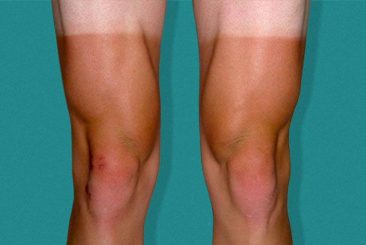
The cyclist’s tan is characterized by a sharp contrast between the tanned and untanned areas of the skin. The most prominent tan lines are often seen on the arms, legs, and face, where cycling attire such as shorts, jerseys, and sunglasses create natural barriers that shield certain portions of the body from the sun’s rays. As a result, these covered areas remain lighter in color compared to the exposed skin.
The cyclist’s tan can serve as a badge of honor for dedicated cyclists, symbolizing their commitment to the sport and the countless hours spent on the road or trail. However, it’s essential to remember that excessive sun exposure without proper protection can lead to skin damage, sunburn, and an increased risk of skin cancer. Therefore, cyclists are advised to take precautions to minimize sun exposure and protect their skin, such as wearing sunscreen, sunglasses, and appropriate clothing that covers exposed areas.
In summary, the cyclist’s tan is a distinctive tan line that develops due to the sun-exposed and covered areas of the body while cycling. While it may be a lighthearted reminder of one’s cycling endeavors, it’s important to prioritize sun protection to maintain healthy skin and prevent long-term damage.
-
Pins and Needles or Numbness
Pins and needles, also known as paresthesia, and numbness are sensory sensations that cyclists may experience during or after a ride. These sensations are often localized to specific body parts, such as the hands, fingers, feet, or toes. They can range from a mild tingling or prickling sensation to a complete loss of sensation in the affected area.
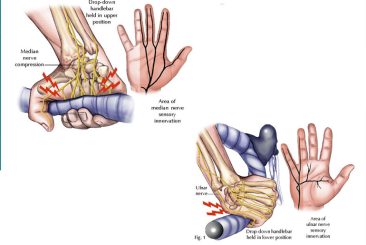
Pins and needles occur when there is temporary pressure or compression on nerves, leading to altered nerve signaling. This can be caused by prolonged pressure on a specific area, such as gripping the handlebars too tightly or resting on them for an extended period. Numbness, on the other hand, is a more pronounced loss of sensation that occurs when nerve function is significantly compromised due to prolonged compression or other factors.
Cyclists commonly experience pins and needles or numbness in their hands and feet. This can be attributed to factors such as improper bike fit, gripping the handlebars too tightly, or constant vibration from uneven road surfaces. Numbness in the genital area, known as “saddle numbness,” is another concern, often caused by pressure on the perineal nerve due to an ill-fitting saddle or poor riding posture.
To address pins and needles or numbness while cycling, it’s essential to focus on proper bike fit and riding technique. Adjusting saddle height, handlebar position, and using padded gloves can help alleviate pressure on nerves and reduce the likelihood of these sensations. Taking breaks during long rides to shift positions, shake out hands, and adjust posture can also help prevent prolonged nerve compression.
In summary, pins and needles and numbness are sensory sensations that cyclists may experience due to nerve compression during cycling. Proper bike fit, ergonomic adjustments, and regular breaks can help alleviate these sensations and promote a more comfortable and enjoyable riding experience.
-
GI Distress
Gastrointestinal (GI) distress is a common issue that many cyclists may encounter during their rides. It refers to a range of discomforting symptoms that affect the gastrointestinal tract, including the stomach and intestines. GI distress can significantly impact a cyclist’s performance and overall riding experience. The causes of GI distress in cycling are multifaceted and can stem from factors such as diet, hydration, intensity of exercise, and individual susceptibility.

During cycling, blood is diverted away from the gastrointestinal tract to the muscles that are working hard. This can lead to decreased blood flow to the stomach and intestines, potentially causing issues like reduced digestion and absorption of nutrients. As a result, cyclists may experience symptoms such as bloating, nausea, stomach cramps, and even diarrhea.
Nutrition and hydration play a crucial role in preventing GI distress. Cyclists need to carefully consider their pre-ride meals and on-bike fueling strategies. Consuming foods high in fiber, fat, or excessive sugars before a ride can increase the risk of GI discomfort. Hydration is equally important; inadequate fluid intake can exacerbate GI issues. Finding the right balance of carbohydrates, electrolytes, and fluids that work well for an individual’s digestive system is key.
Riding intensity also contributes to GI distress. High-intensity efforts can divert blood away from the GI tract, exacerbating symptoms. Moreover, the jarring motion of cycling can also contribute to discomfort, particularly if the rider is not accustomed to prolonged periods in the saddle.
To manage and prevent GI distress, cyclists can adopt a few strategies. Gradually introducing new foods and testing different nutrition products during training rides can help identify what works best for their digestive system. Staying hydrated before, during, and after rides is essential. Paying attention to the timing of meals and fueling can also make a significant difference. Experimenting with saddle height and bike fit to minimize jarring and pressure on the abdomen may alleviate discomfort.
It’s important to note that each cyclist’s body is unique, and what works for one individual may not work for another. Seeking advice from sports nutritionists, dietitians, or medical professionals can provide valuable insights tailored to specific needs. By addressing nutrition, hydration, and training intensity, cyclists can reduce the risk of GI distress and enjoy smoother and more enjoyable rides.
-
Muscle Asymmetry
Muscle asymmetry, a common issue among cyclists, refers to an imbalance in muscle development between the left and right sides of the body. Cycling predominantly involves repetitive motions that target specific muscle groups, potentially leading to uneven muscle growth. This condition can affect a cyclist’s performance, posture, and overall biomechanics.
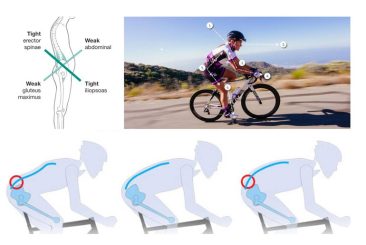
Cycling primarily engages the quadriceps, hamstrings, calves, and gluteal muscles. When one leg works harder than the other, due to factors like pedaling technique or physical imbalances, it can lead to muscle asymmetry. This imbalance can impact power output, efficiency, and even increase the risk of injuries.
The quadriceps, responsible for extending the knee, are particularly susceptible to muscle imbalances. Overdeveloped quads on one side can lead to knee tracking issues and potential discomfort. Moreover, asymmetry in the hip and gluteal muscles can affect the alignment of the pelvis, altering posture and potentially leading to lower back pain.
Cyclists can address muscle asymmetry through targeted strength training and corrective exercises. Working with a professional, such as a physical therapist or strength coach, can help identify imbalances and design a customized training plan. Exercises that focus on single-leg movements, such as lunges and single-leg squats, can help rebalance muscle development.
Proper bike fit is another crucial consideration. An ill-fitting bike can exacerbate muscle asymmetry by promoting unequal pedal force distribution. Ensuring that the bike is adjusted to accommodate an individual’s unique biomechanics can contribute to more balanced muscle development.
Stretching and flexibility exercises also play a role in preventing and addressing muscle asymmetry. Tight muscles on one side of the body can hinder proper movement and exacerbate imbalances. Incorporating a well-rounded stretching routine can help maintain flexibility and address muscular discrepancies.
Cyclists should be patient and persistent in their efforts to correct muscle asymmetry. It’s important to recognize that achieving perfect symmetry might not be entirely realistic due to natural anatomical variations. However, by consistently working on strength training, flexibility, and bike fit adjustments, cyclists can minimize muscle imbalances and improve their overall performance and comfort on the bike.
Despite these peculiar effects, it’s important to remember that cycling remains a great way to stay active and improve your fitness. Many of these issues can be minimized or avoided with proper technique, equipment, and self-care. If you’re new to cycling or experience any discomfort, consulting with a cycling coach or healthcare professional can help ensure a safe and enjoyable riding experience.
Disclaimer:
The information contained in this article is for educational and informational purposes only and is not intended as a health advice. We would ask you to consult a qualified professional or medical expert to gain additional knowledge before you choose to consume any product or perform any exercise.

